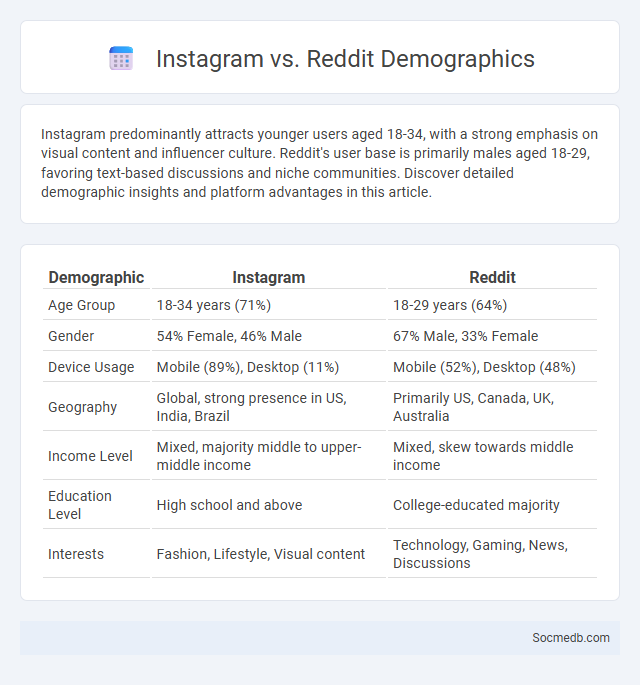
Photo illustration: Instagram vs Reddit demographics
Instagram predominantly attracts younger users aged 18-34, with a strong emphasis on visual content and influencer culture. Reddit's user base is primarily males aged 18-29, favoring text-based discussions and niche communities. Discover detailed demographic insights and platform advantages in this article.
Table of Comparison
| Demographic | ||
|---|---|---|
| Age Group | 18-34 years (71%) | 18-29 years (64%) |
| Gender | 54% Female, 46% Male | 67% Male, 33% Female |
| Device Usage | Mobile (89%), Desktop (11%) | Mobile (52%), Desktop (48%) |
| Geography | Global, strong presence in US, India, Brazil | Primarily US, Canada, UK, Australia |
| Income Level | Mixed, majority middle to upper-middle income | Mixed, skew towards middle income |
| Education Level | High school and above | College-educated majority |
| Interests | Fashion, Lifestyle, Visual content | Technology, Gaming, News, Discussions |
Overview of Instagram and Reddit Platforms
Instagram, a photo and video-sharing social media platform owned by Meta, boasts over 2 billion monthly active users, emphasizing visual content, Stories, Reels, and influencer marketing. Reddit, a community-driven platform with more than 52 million daily active users, offers a diverse range of forums called subreddits, enabling users to engage in discussions, share content, and vote on posts. Both platforms serve different user needs: Instagram prioritizes visual storytelling and brand engagement, while Reddit focuses on topic-specific content and community interaction.
Global User Demographics: Instagram vs Reddit
Instagram commands over 2 billion monthly active users worldwide, with a strong presence among 18-34-year-olds, especially in urban regions across North America, Europe, and Asia. Reddit, hosting around 560 million monthly active users, attracts a predominantly young and tech-savvy audience, particularly males aged 18-29, with significant engagement in the United States, Canada, and the United Kingdom. The platform demographics highlight Instagram's dominance in visual content and lifestyle communities, while Reddit excels in niche interests and discussion-based content across a global but more concentrated user base.
Age Distribution Comparison
Social media platforms display distinct age distribution patterns, with younger users dominating platforms like TikTok and Snapchat, while Facebook and LinkedIn attract more mature audiences, typically aged 30 and above. Understanding these demographics helps tailor content strategies to engage your target age group effectively. Analyzing age data highlights trends, such as the growing presence of millennials and Gen Z in visual-driven platforms, enhancing your social media marketing impact.
Gender Breakdown Analysis
Social media platforms exhibit distinct gender breakdowns, with women comprising approximately 54% of users on Facebook and men dominating platforms like Reddit at around 67%. Instagram shows a relatively balanced gender distribution, with females accounting for 50-52% of its user base, reflecting targeted content preferences. Analyzing gender-specific engagement patterns reveals that women are more active in sharing and commenting, while men tend to engage more with gaming and technology content.
Geographic Reach and Regional Popularity
Social media platforms vary significantly in geographic reach, with global giants like Facebook, Instagram, and TikTok dominating markets worldwide, while region-specific networks such as WeChat in China and VKontakte in Russia hold strong local user bases. Understanding the geographic distribution and regional popularity of these platforms helps you tailor content and marketing strategies to maximize engagement and growth in targeted areas. Leveraging regionally popular platforms can enhance localized brand presence and foster deeper community connections.
Socioeconomic Status and Education Levels
Social media usage patterns vary significantly by socioeconomic status and education levels, influencing access to information and digital literacy. Higher education often correlates with more critical engagement and diversified content consumption, while lower socioeconomic groups may face barriers limiting digital inclusion and online opportunities. Your awareness of these disparities can guide more equitable social media strategies and foster inclusive digital environments.
Urban vs Rural User Base
Social media usage patterns reveal significant differences between urban and rural user bases, with urban users exhibiting higher engagement rates, diversified platform preferences, and greater access to high-speed internet. Rural users tend to favor community-oriented platforms and display more consistent usage during peak offline hours, highlighting the importance of localized content and connectivity infrastructure. Understanding these distinctions aids marketers in tailoring campaigns and improving digital inclusivity across diverse geographic regions.
Content Engagement Differences by Demographic
Content engagement on social media varies significantly across demographics, with younger users typically showing higher interaction rates on platforms like TikTok and Instagram compared to older generations who prefer Facebook. Gender also influences engagement patterns; women tend to engage more with visual and lifestyle content, while men often interact with sports and technology topics. Understanding these differences helps tailor your social media strategy to maximize reach and audience connection.
Brand and Influencer Appeal
Social media platforms amplify your brand's visibility by connecting it with targeted audiences through influencer collaborations that drive authentic engagement. Influencers enhance brand appeal by leveraging their trust and credibility to promote products, creating a personalized connection that traditional advertising cannot match. Effective influencer partnerships boost brand awareness, increase customer loyalty, and generate measurable ROI by aligning influencer content with your brand values.
Demographic Trends and Future Projections
Social media usage continues to grow rapidly, with platforms like TikTok and Instagram dominating younger demographics aged 18 to 34, while Facebook retains a strong user base among those aged 35 to 54. Analysts predict that by 2026, over 80% of the global population will be connected to at least one social media platform, driven by increased smartphone adoption and improved internet access in emerging markets. Understanding these demographic trends helps you tailor content strategies to engage the right audience effectively and anticipate future shifts in user behavior.
 socmedb.com
socmedb.com